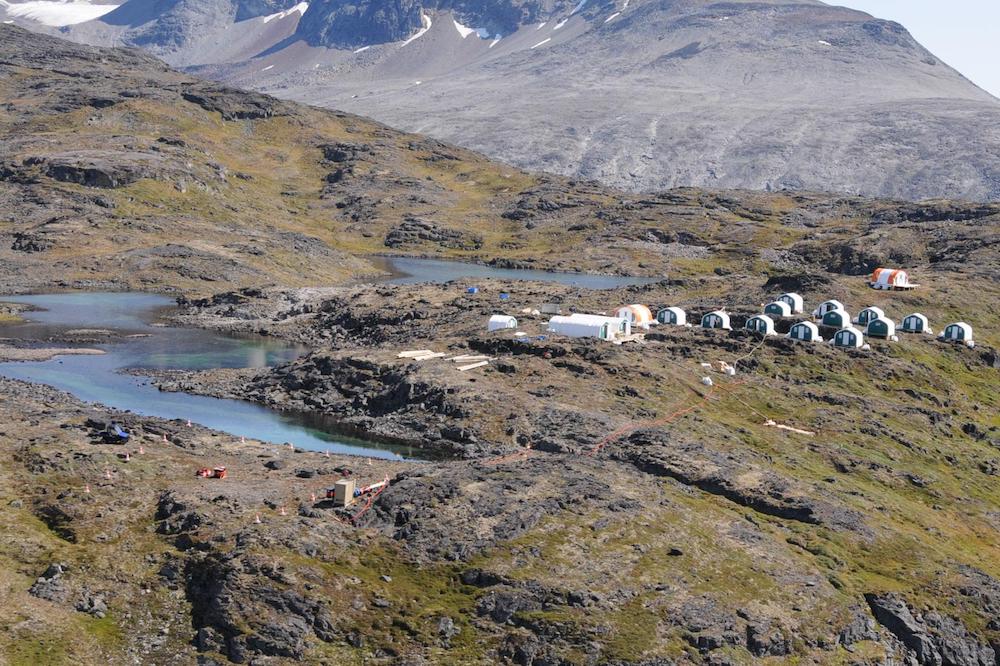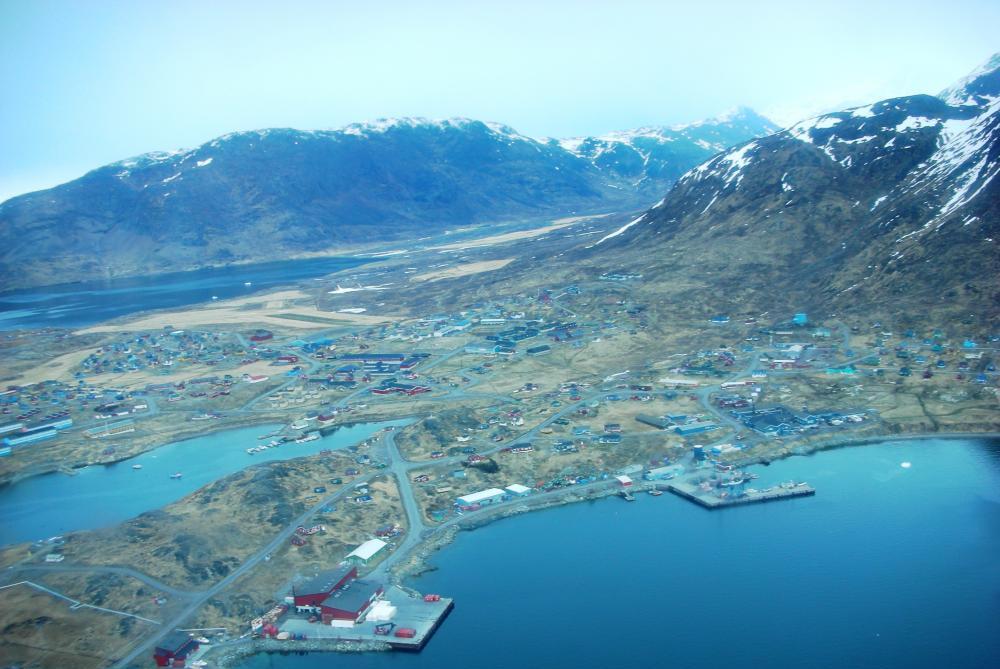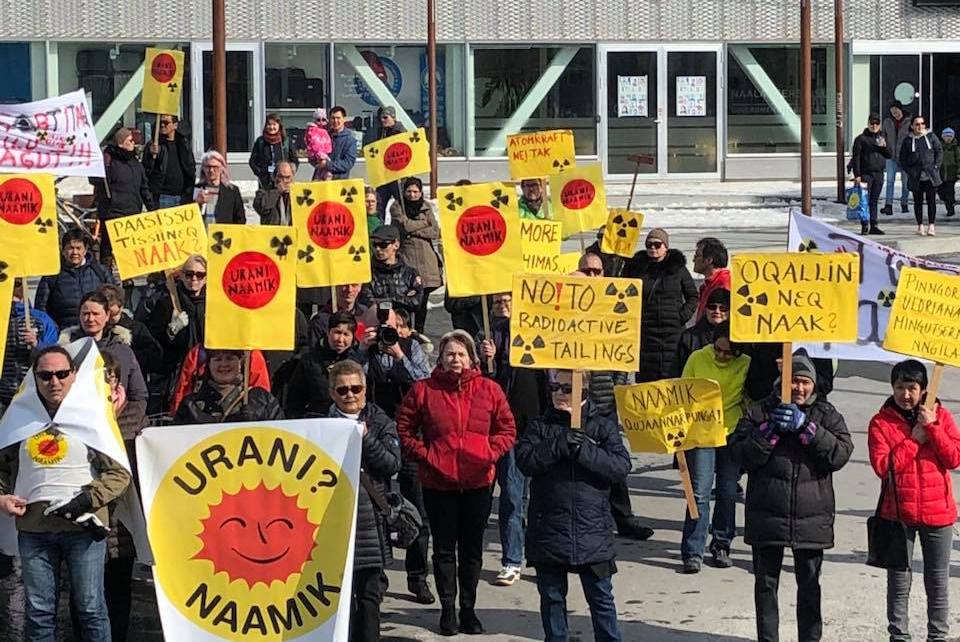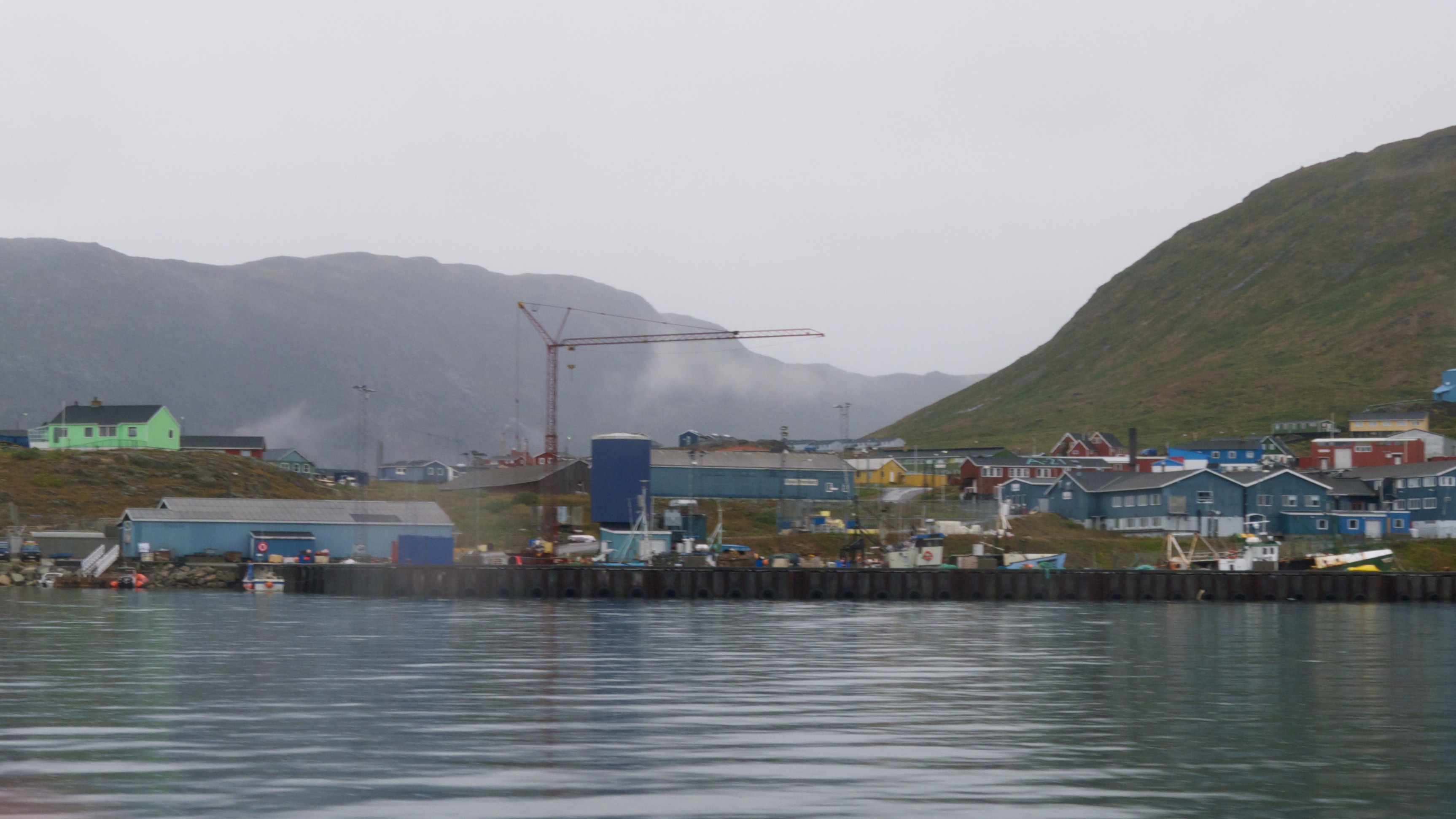Public hearings on a controversial Greenland mine get underway
The political approval process for the Kuannersuit (or Kvanefjeld) rare earths and uranium mine near Narsaq began on Friday.

After a brief summer visit to the small town of Narsaq in grassy southern Greenland, Danish nuclear physicist Niels Bohr, famous for his Nobel Prize and his part in the Manhattan Project in the U.S. that led to the first nuclear bomb, had a small square named after him. Last time I was in Narsaq, the diminutive sign was still testifying to the event: “Niels Bohr Square.”
While the sign was put up, Danish soldiers worked their geiger counters on Kuannersuit, a nearby mountain, where geologists had found extraordinary amounts of radioactivity. The ambition was to bring uranium from Narsaq — which is, according to the 1,350 local inhabitants, the most beautiful town in Greenland — to Denmark for use in yet-to-be developed nuclear power plants.
A mine shaft, the mouth of which can still be seen, was drilled halfway up the mountain, and in 1980 more than 4,200 tons of ore was shipped to Denmark for closer scrutiny. Shortly after, Denmark decided never to build any nuclear power plants, and the importance of Greenland’s uranium paled to the same color as Niels Bohr. Instead, the lead role was given to the so-called rare earths, the superminerals of our time.
Kuannersuit (also known as Kvanefjeld) holds one of the largest known deposits of rare earths in the world. Rare earths, which include 17 different minerals, are found in many places on Earth, but nowhere in as tempting amounts and compositions as in Narsaq, and the mine on the top of Kuannersuit, some 600 meters above sea level, has never been closer to becoming a reality than today.
[A decade on, a Greenland rare earths mine is close to final approval]
Which is why the political process that was officially started on Friday could have far-reaching effects, including influencing the national defense of the U.S. and its allies, the emergence and growth of technologies the world needs for the fight against global warming and the future of Greenland.
Another mining project, Tanbreez, which lies less than 50 kilometers away, also holds rare earths and is also edging closer to fruition, but Tanbreez is smaller, has no uranium, and most political attention is presently on Kuannersuit.
Political support
After 10 years of wrangling with Greenland Minerals A/S, the mining company behind the plans for Kuannersuit, Greenland’s environmental authorities have tentatively approved the company’s plans for environmental protection at the proposed mine and the plans for other interaction with the surrounding society. Now that the relevant documents have been translated into Greenlandic, which is Greenland’s official language, the final political process has begun. For now, a majority in parliament has declared itself in favor of the mine, if no unexpected environmental problems are unearthed during the public hearings.
Greenland’s young liberal minister for raw materials, Jens Frederik Nielsen, is openly supportive:
“This is an important mine. It will create jobs and economic growth. It would be great if we were already at the finishing line, but we must of course follow the law and the process must be allowed to be played out,” he told me in Nuuk a few days ago.
With the necessary reservations he predicts that the mine may open “within a year, perhaps only half a year.”
This is epoch-making.
Indispensable minerals
If you look at Kuannersuit from the air, you will see large whitish patches of mountain with little or no vegetation. The rare earths are sufficiently potent to be easily detected, and while most people have no inkling as to their practical use, their importance to the world has grown almost as fast as that of uranium back when nuclear power was in the making.
Today, scores of crucial technological inventions are highly dependent on rare earth minerals. These minerals, with names like neodymium, praseodymium, terbium and dysprosium, are indispensable in the electronic fridges, self-driving cars and other electronics that are to communicate through the internet of things. They are at work in the computer I write on, in my cell phone — and in navigation systems for nuclear missiles. They are used in solar panels and they are essential in magnets for the pumps, windmills and electrical vehicles that are paramount for the fight against global warming.
Without the rare earths many of the political ambitions to combat the climate crisis would be endangered. According to Greenland Minerals, Kuannersuit is particularly rich in four of the key minerals — the ones mentioned above. During a briefing in Nuuk, Jørn Skov, the company’s new executive managing director, told me that Kuannersuit may satisfy towards one-fifth of the world’s demand for these four:
“I think it is a fantastic story. Greenland can deliver 15-20 percent of what is needed to drive the green transition. This is the world’s greatest challenge, and imagine that Greenland can help solve this. Meanwhile, Kuannersuit may also solve some of Greenland’s own fundamental economic problems,” he says.
Over the last 10-12 years Greenland Minerals have drilled more than 70 kilometers of holes into Kuannersuit and the size and composition of the mineral deposits have been certified by Australia’s Joint Ore Reserves Committee. Documentation is important: Jørn Skov and Greenland Minerals’ Australian holding company need investors who are willing to invest $1.2 billion in order to establish the mine — if the political permission is granted from Nuuk.
[A controversial Greenland mine passes a key regulatory hurdle, and heads for public comment]
Kuannersuit lies a bumpy six- or seven-kilometer journey along a gravel road from Narsaq. The route takes visitors past the garbage dump, then a small bay and left of Sofus’ and Suka Frederiksen’s farm, where a small herd of Greenland’s very few cows feed. (Suka, a former minister of foreign affairs for Greenland, died this summer after a long illness.) The cows are low and compact, a small dark Arctic variant of the ordinary cow, but they are sweet and smart and eye passers by without consternation. After the farm, the gravel path rises more steeply towards Kuannersuit. Cars have to stop half way up the slope, not far from the old mine shaft. The rest of the Kuannersuit is climbed by foot.
I heard on an earlier occasion that Greenland Minerals might buy Sofus’ farm. Even Jørn Skov’s engaging presentation does not exclude the possibility that a mine on top of Kuannersuit’s uneven plateau, where some 1,200 workers are due during the construction phase, will produce such amounts of dust and so much trucking with heavy vehicles that the area closest to the mine might be somewhat contaminated.

For years, large yellow signs stuck on containers from Greenland Minerals near Sofus’ farm have warned bypassing locals against potential nuclear radiation, and many of Narsaq’s citizens are nervous. They fear for their children’s health, for the sheep in the valleys, the fish and the whales in the fjord, for the nascent south Greenland veggie-farms, for the wild berries on the mountain, for their peace of mind and tranquility. Some years back, rumors had it that the whole of Narsaq will close or have to relocate if the mine moves in.
American interest
And do all these details carry any importance to other than the locals? Yes, indeed.
In the summer of 2019 U.S. President Donald Trump issued a presidential memoranda for publication in the Federal Register. The president asked his Secretary of Defense, Mark Esper, to take note of the president’s concern that the U.S. does not possess sufficient capacity for the production of minerals from rare earths.
The president sternly suggested other ways forward: “Without Presidential action under section 303 of the Act, United States industry cannot reasonably be expected to provide the production capability for separation and processing of Light Rare Earth Elements adequately and in a timely manner. Further, purchases, purchase commitments, or other action pursuant to section 303 of the Act are the most cost-effective, expedient, and practical alternative method for meeting the need for this critical capability.”
The president wanted increased effort to solve the problem, and three weeks later he confirmed that he had indeed contemplated buying the whole of Greenland — including its 57,000 inhabitants, sled dogs — and minerals. As many will recall, the offer was promptly rejected by both Greenland and Denmark, which still holds sovereignty over Greenland.
But the pursuit of Greenland’s minerals continued. For three weeks in August 2019, a U.S.-sponsored airborne survey for new deposits took place in southern Greenland, and when Thomas Ulrich Brechbuhl, chief advisor to U.S. Secretary of State Mike Pompeo visited Greenland in October 2019, the rare earths once again played an important role. In June this year, the Pentagon asked Congress to legislate to secure sufficient rare earths for U.S. defense. The news portal DefenseNews reported that the proposed legislation would raise spending caps under the Defense Production Act to enable the U.S. government to spend up to $1.75 billion on rare earth elements in munitions and missiles.
A Chinese shareholder
In 2016, China’s interest in Kuannersuit became evident as the Chinese mining conglomerate Shenghe bought 12.5 percent of Greenland Minerals’ shares. Shenghe is still the company’s largest shareholder, though now with 9 percent of the shares. The point here is, that China controls more than 90 percent of the global production of minerals from rare earths. The process of separating the minerals from the ore is technologically demanding, expensive and messy, particularly since acids are used in the extraction process. The Chinese companies are world champions in this and the EU and the U.S. both worry that China might use its monopoly for pressure.
Which is why it did not go unnoticed when, in 2018, Greenland Minerals signed a non-binding agreement with Shenghe, which stipulated that Shenghe might eventually buy the total output of rare earths from Kuannersuit, some 32,000 tons of ore.
“Shenghe have expressed an intent to acquire all rare earth output produced at the project whether as a mineral or chemical concentrate product on arm’s length pricing reflecting published internationally traded prices,” Greenland Minerals wrote in a press release, after which the company’s stocks went up. In January 2019 Shenghe signed a deal with China National Nuclear Corporation, which was also to enjoy the fruits from Kuannersuit. According to the Federation of American Scientists, the state-owned CNNC is a key developer behind China’s nuclear power supply as well as China’s arsenal of nuclear weapons
A market in Europe
Today, however, any focus by Greenland Minerals on direct sales to China seems to have evaporated. Instead, representatives of Greenland Minerals hold sales talks in Brussels. In September, the EU Commission launched a wide ranging campaign to secure supplies of rare earths and other strategic minerals to Europe. The EU Commission wants to connect European industries with producers of rare earths like Greenland Minerals, and Jørn Skov finds the approach promising.
Shenghe from China will still deliver the necessary technology for the mine at Kuannersuit, just like Shenge provides knowhow and technology for the Mountain Pass rare earth mine in California, where Shenghe is also a shareholder; not even the U.S. makes do without China’s expertise. But Greenland Minerals’ strategy is now to sell the entire package of valuable rare earth content from Kuannersuit in Europe. Time will show if this also goes for the uranium from Kuannersuit that Niels Bohr looked for six decades ago. Any export of uranium from Greenland must be preceded by a detailed agreement between Denmark and the end user country.
“We cannot say anything about this at this stage,” says Jørn Skov.
A radioactive byproduct
Greenland Minerals talks about the uranium as a byproduct from the potential mine that will inevitably be unearthed as the rare earths are excavated. But even if uranium makes up only a small portion of Greenland Minerals’ planned production, it pains many souls and minds in Greenland.
The citizens of Narsaq and many in the rest of Greenland have been bitterly divided over uranium since the 1980s. In 2014, a ban on uranium mining in Greenland was lifted by a single vote in the Inatsisartut, Greenland’s parliament.

The opposing forces have united in Urani Naamik, a Uranium-No-Thanks-association, and Muté B. Egede, chairman of Inuit Ataqatigiit, Greenland’s largest opposition party, who is also a southerner, was more than blunt in his dismissal of the mine on Kuannersuit when I asked him earlier this year:
“We are against uranium in Greenland, both exploration and mining. It divides our population, and we don’t think that Greenland should be turned into a waste depot for future generations. There are other and more sustainable businesses we would much rather help develop in southern Greenland,” he said. His party argues for a referendum on uranium and talks strongly about the waste issue.
[As Greenland nears uranium decision, opponents fear public won’t be heard]
Each year, Greenland Mining will crush three million tons of ore at Kuannersuit and export only a tiny fraction. The rest, the so-called tailings, are to be deposited in a large lake on top of Kuannersuit.
The head of the Nuuk office of the Arctic Program of the World Wildlife Fund, Kaare Winther Hansen, also remains skeptical:
“First of all, Greenland Minerals will not ship its chemical waste out of Greenland. They want to dump it in a lake behind an artificial dam, and there are doubts about these dams: Will they last or will they not? We are not impressed. Secondly, they will not establish an underground mine, but an open pit mine on a location with thorium, uranium and fluoride compounds, which are potentially dangerous and likely to spread in the surrounding area since it is an open pit mine. The citizens of Narsaq live only 5 kilometers from the nearest part of the mine. They use surface water for drinking, so you will also have a dust-problem,” he says.
Greenland Minerals habit of headhunting the most capable of the Greenland governments own staff also irks the critics. They object when top civil servants exchange their access to confidential government information with top tier jobs with Greenland Minerals. From the outset in 2007 the company hired the head of the Department of Raw Materials in Nuuk. A few years laters, Lars-Emil Johansen, a former member of Greenland’s government and former head of Siumut, Greenland’s largest political party, took on the position as chairman of the board Greenland Minerals and in July this year Jørn Skov took the plunge.
For more than two decades until shortly before accepting his present executive position with Greenland Minerals, Skov worked as head of key departments within Greenland’s government. He was well known for his profound influence on legislation pertaining to Greenland’s raw materials; one of the most powerful shadows behind Greenland’s front line politicians.
“I am probably not the least controversial figure in the country,” as he says.
“We find it scary,” said the former head of Urani Naamik, Marianne Paviasen, who is now a member of parliament for Inuit Ataqatigiit.
An economic boost
Jørn Skov, who also took with him a trusted colleague, did not break any laws when he went to work for the mining company, and the Kuannersuit mine enjoys support from a majority of Inatsisartut, at least until further notice. The support is garnered primarily because of the promise of more than 700 permanent jobs in Narsaq, all in the mine.
Such a boom would cause a revolution in south Greenland, a region painfully suffering from unemployment and from a serious exodus of many young and qualified people. More than half of the 700 jobs at the proposed mine at Kuannersuit will go to foreigners, since Greenland cannot provide the needed number of skilled hands, but still: According to Greenland Minerals’ own estimate, Greenland’s treasury is likely to receive more than $200 million per year in taxes and other income throughout the life of the mine. Should such sums really materialize, Kuannersuit may potentially help solve a major part of Greenland’s economic woes.

“We will simply close the holes in Greenland’s economy,” says Skov.
To the more eager, this may make Greenland’s secession from Denmark look more realistic; Greenland’s first ever constitution is already in the oven. Jens Frederik Nielsen, the minister for raw materials, does not talk of secession or high politics at all, but he readily shares his high expectations:
“For me, wealth is the jobs we create and the tax revenue that follows. We can build new competences and we will have a ground for new developments in southern Greenland, that is still badly hurting. That is the most important to me,” he tells me. Nielsen seems convinced that the environment will be handled responsibly:
“We have good legislation on raw materials, which forces the companies to adhere to very hard demands. I have much sympathy for the concerns about radioactivity within the local population. I have talked to the association about this; but I trust our legislation,” he says.
The public hearing about Greenland Minerals’ plans for environmental protection and for the potential mine’s interaction with the rest of society will probably last at least 10 weeks. Afterwards, all complaints must be registered and addressed by the authorities or Greenland Minerals.
When this is over, Greenland’s political leadership in Nuuk, the parliament and Naalakkersuisut, the government, will make a final decision whether the mine on Kuannersuit will be allowed to go ahead or not.